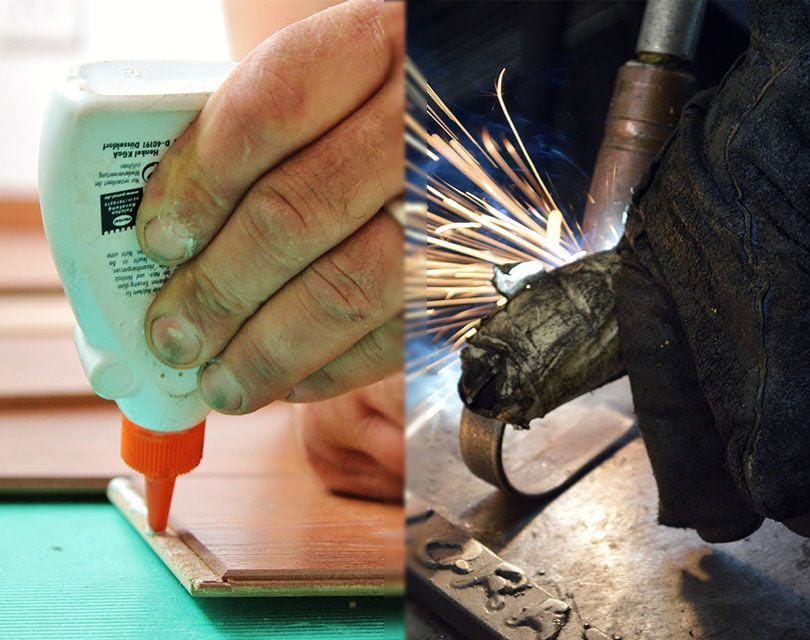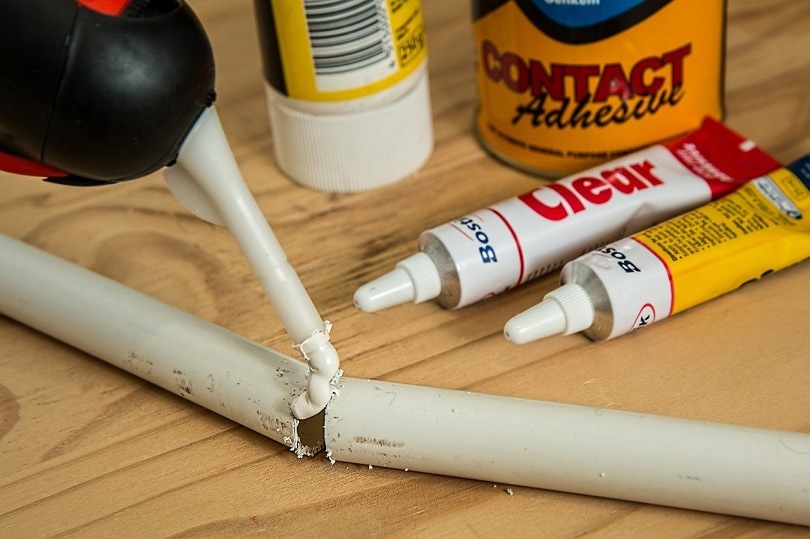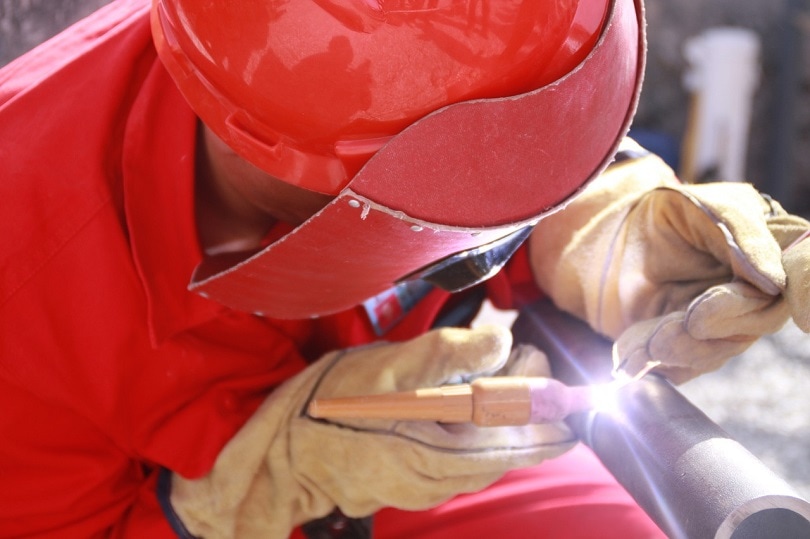Body Panel Adhesive vs. Welding: Which Method Should You Use?
Last Updated on

At the fabrication stage, it is crucial to create permanent joints that will help secure the parts. There are certain specifications we consider when deliberating between welding or body panel adhesive. Knowing the best method to use requires experience and adequate technical knowledge to ensure that the method selected is the most suitable.
Welding thin metal, dissimilar metal material, aluminum, and stainless steel has always been a challenge; this is where adhesive bonding comes in. Adhesive bonding is a technical and unique method standard in auto assembly, aircraft construction, and even skyscrapers’ construction. Different types of adhesive components are integrated with other materials to achieve the desired results.
Read on to see our body panel adhesive vs. welding comparison and learn more about each of these methods. However, before we dig deep into their differences, let us explain each of them by highlighting the application, advantages, disadvantages, and how the two methods compare.
Body Panel Adhesive Overview

Today, the most common adhesive in the market is cyanoacrylate, ordinarily known to many as super glue. It can hold different materials together, but humidity, heat, water, and time can wear it off.
Body panel adhesives are useful in automotive, aerospace, and structural construction processes. In this case, body panel adhesive is used in building car body parts by bonding metal-to-metal and other composite materials used in low volume and high-end car manufacture for a longer-lasting bond.
Placing gaskets and sealing materials can only be bonded to metal using a pressure-sensitive adhesive (PSA).
Application
During motor vehicle assembly, body panel adhesive reduces the vehicle’s weight, speeds up the production process, and enables corrosion protection. It glues together the body skin, quarter panels, and roof skins. The following are some of the standard applications of body panel adhesive in vehicle assembly.
- Watershield Bonding: Film bonding that directly bonds to the vehicle’s door top protects the electrical components from water and moisture damage. Body panel adhesive meant for water shield bonding can exist as directly applied systems or as pre-applied.
- Weatherstrip Bonding: Bonding that protects the vehicle’s interior from environmental damage. The body and adhesive used here have to be flexible even after curing because it has to withstand the vehicle’s vibrations. The body panel adhesive must also retain its properties of bearing extreme temperatures and pressure fluctuations.
In aerospace, various composite materials are used as raw materials in the building and assembling aircraft bodies. In such an instance, it is better to use adhesives because it does not require fasteners, bolts, or nuts, as there are no holes to be drilled. The bonding of honeycomb structures and other aerospace structures often involves fasteners to the metals’ hardpoints.
In structural application, most modern buildings glue the different glass, metal, and wood parts using adhesive. It is also used in bonding exterior cladding because it eliminates stress risers and improves the aesthetic value. Using adhesives is cost-effective in construction because the building will consume less material and that the structure will not be very heavy.
- Lightweight
- Vibration and noise reduction
- Distributes stress across the bonding area
- Offers increased fatigue strength
- Permanent bonding
- Less labor-intensive
- Curing time required
- Limited shelf life
Welding Overview

Welding automotive parts such as the transmission, engine, fuel injectors, solenoids, air conditioning system, fuel system, gear components, and alternators require laser welding. This is because laser welding attractions on these applications can weld together pre-machined components with minimal distortion and restricted heat. It also ensures that optimum compactness is achieved and saves on weight through the use of thin-walled assemblies.
The numerous advantages of laser welding have made it widely adopted in the automotive industry over other alternatives, like electron beam welding. It also lowers the cost of production and reduces downtime compared to vacuum-based systems.
Application
For the last 40 years, resistance spot welding dominated the mass production of car body parts fabrication from pressed steel sheets.
- Single-sided access
- Reduced flange width
- Increases torsional stiffness
Laser welding improves a vehicle’s structural performance and gauges the thickness of the materials used. It also reduces the areas affected by heat, lowers thermal distortion, speeds up production, used in automation processes, and flexibility in multi-layer joints.
Laser welding has replaced resistance spot welding, i.e., today, welding of side panels and car roofs is one of the most common applications. It has a double-layer lap joint of steel coated with zinc and a triple thickness layer welded over a length of 2.5 to 3m.
Future of Automotive Welding Application
Predictably, the future of automotive laser welding will continue growing at a substantial rate.
- Welding magnesium alloy components
- Node structures production in aluminum casting
- Hydroformed tubes or extrusions from pressed components
- Stiffened structures consisting g of welded sheets
- Production of tailored hydroformed tubes
Successful welding application depends on the weight of materials, type of materials, performance, cost, the structure of the product, environmental factors, and production volume. Welding has served, for several years, as one of the trusted procedures in building automotive parts.
- No need for curing time
- Welding is an instantaneous procedure
- Creates powerful bonds
- Bonds even at high temperatures
- Has an unlimited shelf life
- Permanent bond
- Limited to groups of similar material
- Accelerates corrosion rate
- Sometimes dressing is required
- Labor intensive
- Distortion and discoloring of thin metal
Welding Versus Body Panel Adhesive
Welding is a process that involves a lot of heating, which is both its strength and weakness. It is easier to weld materials that are similar since they have identical properties, such as the melting point. The two fuses together when they reach the melt pool and then bond together. Metals also undergo less distortion and are at a lower risk of damage, making the bond strong and durable.
On the other hand, body panel adhesive is gluing together automotive body parts of different or similar materials using an adhesive bond material. The bond requires curing time for the materials to stick together and create a robust and cohesive bond that is flexible and durable. These adhesives do not react with galvanized surfaces and cannot capable of discoloring, destroy, or distort thin metals.
Factors to Consider
Before we settle on a suitable method for your project, there are other factors to look into.
Environmental Factors
The method you settle for should consider environmental factors that the finished product has to endure. It will aid you in selecting the most appropriate method during the manufacturing stage. Heat, humidity, and water are environmental factors that affect both welding and adhesives.
Climatic conditions also pose environmental challenges, considering that every climatic zone has certain conditions that might favor or affect the chosen method. For instance, heat and humidity harm adhesives by making them detach from the other materials, hence losing the bond over time.
The shape of the material greatly determines how it adapts to environmental factors. Cars have a streamlined shape because of aerodynamics; the shape allows the body panel adhesive and welds to stay strong by enabling it to break through the air with minimal resistance.
Time
Body panel adhesive needs more time to enable the material to bond properly. The waiting period is called curing time. During this time, the adhesive bonds perfectly with the material. On the other hand, welding is instantaneous, and this makes it fast.
Both processes are time-consuming, mostly when done under mass production, and if the process is not fully automated, welding consumes much less time than body panel adhesive.
Safety
Safety starts with protecting the people working with these materials and bonding methods. When welding, we ensure that our working staff wears gloves, eyewear, hearing and respiratory protection equipment, and safety boots.
On the other hand, when working with body panel adhesive, ensure that you wear respiratory aids such as a gas mask, gloves, and glassware. The chemicals used in manufacturing the adhesive cause skin and eye irritation. People with pre-existing respiratory conditions like asthma should keep away from adhesive materials.
Safety also translates to how the method used makes the product safe. For example, when welding or using body panel adhesive in the automobile industry, the above-mentioned safety procedures come in handy. The bonding method ensures that the vehicle is safe from environmental factors and strong enough to resist corrosion, absorb vibrations, withstand all-natural ecological conditions, and resists natural energy forces.
Cost
Regarding the production cost, choosing between welding and using body panel adhesives can be a gruesome task. Most automotive assembly lines use different methods to assemble different body parts depending on areas that require bonding. Reduced production cost directly affects the price of the final product and the type of materials used.
In welding, we have to incur the cost of power since electricity is vital in this process. Body panel adhesive does not need any power source; the application is achievable by hand. However, the cost of buying may be more costly compared to purchasing a simple welding machine.
Difference Between Welding and Body Panel Adhesive Methods
- Welding bonds two metallic objects instantly, while body panel adhesive requires some curing time.
- Welding can be done even in scorching environments, while body panel adhesive requires that the application is down under certain conditions.
- Welding requires a lot of energy, while body panel adhesive requires limited power for a successful application process.
- Welding is only possible for metal materials with similar properties, while body panel adhesive can glue together different materials with different properties.
- Welding discolors and distorts thin metals while using body panel adhesive does not affect any materials used.
- Welding is suitable for permanent sealing, while body panel adhesive is appropriate for flexible joints and panels.
Similarities Between Using Body Panel Adhesive and Welding
- Both are good for an automated process
- Both are labor-intensive activities
- Both require you to wear protective gear
- Both are durable and create strong bonds
- Both can bond metals
When to Use
Both welding and body panel adhesives have their advantages and disadvantages. Each of them is best used in controlled conditions and for specific purposes.
When to Use Body Panel Adhesive
When to Use Welding
When bonding dissimilar materials
Bonding metals with similar properties
Flexible joints
Permanent sealing
Longer production time
No cure time needed
Surface preparation needed
Surface preparation needed
Best for thin metal, galvanized surfaces, and high thermal conductivity metals
Thick metal
Less clean up time
Has a lot of cleanup activities required
Automated industrial processes
Hand made from human labor
Which Method Should You Use?
So which is the best method? If you plan on building something that has to be flexible, durable, and lightweight, body, panel adhesive would be a great choice. Adhesive bonding can bond dissimilar materials and work correctly with thin metals in automotive body parts building. If you are interested in a quicker way to bond the metals and create a permanent sealing, welding is the best option.
Featured image credit:
